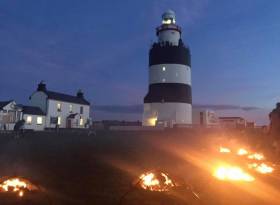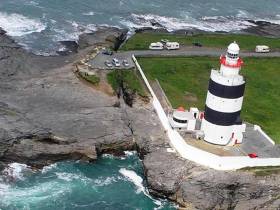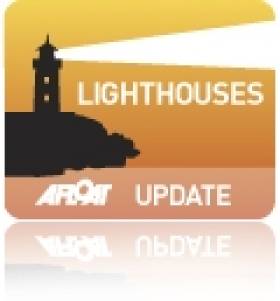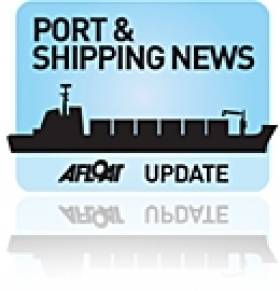Displaying items by tag: Hook Head Lighthouse
Hook Head Lighthouse Will Have Traditional Arrow Ceremony on New Year's Day
A unique event is set to take place at the oldest intact operating lighthouse in the world this New Year’s Day.
On New Year’s Day at 1.00 pm, an age-old tradition takes place at the 800-year-old Hook Lighthouse in County Wexford as the Dunbrody archers participate in a traditional Arrow ceremony.
The Dunbrody Archers will join the Cathaoirleach of the Municipal District of New Ross Council, Cllr Michael Sheehan, to participate in the Arrow ceremony. This ancient tradition dates back to 1687 when the Mayor and the corporation of New Ross Town Council claimed their authority over the Tower and waters by travelling to the point of the Hook and shooting an arrow into the sea from Hook Head Lighthouse.
The Cathaoirleach will be joined by the Dunbrody Archer for the impressive ceremony as they all cast biodegradable arrows into the sea.
 Pictured last year at the 800-year-old Hook Lighthouse in County Wexford is Joszef Sztana from Hungary as he performs an Arrow Ceremony, an age-old tradition dating back to 1687 Photo: Patrick Browne
Pictured last year at the 800-year-old Hook Lighthouse in County Wexford is Joszef Sztana from Hungary as he performs an Arrow Ceremony, an age-old tradition dating back to 1687 Photo: Patrick Browne
On New Year’s Day 2023, the Mayor will cast an arrow into the sea, symbolising the Port's authority over the estuary. Members of the public are invited to watch the free historical event at 1.00 pm.
Commenting on the upcoming event, Lorraine Waters at Hook Lighthouse said, “This is always an incredible occasion to witness and we are delighted to have a full return of this occasion for the first time since 2019 and to continue the ancient tradition, right here on the cornerstone of Ireland’s Ancient East.”
Hook is renowned as the oldest intact working lighthouse in the world; from the 5th-century, monks lit fires to warn Ships of the treacherous waters around Hook Head. The Hook Lighthouse tour incorporates 115 steps to the top of the tower, featuring holograms illustrating the ancient history of the tower and the Hook area and spectacular views of the southern coast.
Hook Lighthouse Visitor Centre and Café closes on December 20th at 5 pm, re-opens on 26th St Stephen’s Day at 11 am, and will remain open throughout the holiday season.
Culture Night 2017: Join in the Harvest Moon Celebration at Hook Head Lighthouse
#CutlureNight - Among the numerous events of Culture Night 2017 there are those with a distinct maritime theme. A notable event taking place on the night (Friday 22 Sept) is the annual Harvest Moon celebration at Hook Head Lighthouse, Co. Wexford.
So come along to this second year of the autumnal event and enjoy watching the sunset and harvest moon rise over Hook Peninsula beneath the protective beam of the world’s oldest intact operational lighthouse.
A special late opening from 6pm will take place at the Lighthouse Visitor Centre, where you are invited to come along and find a spot on the straw bales around the fire-pits on the lighthouse lawns and watch nature at its best during the autumn equinox.
Why not also enjoy some treats from the Hook Lighthouse Barbeque and some Hook Pilsner. Take a sample of the brand new Hook beers and a harvest brew from Arthurstown Brewing Company which have all been locally brewed from the harvesting of grown malted barley.
Also at this beautiful coasting setting will be Musicians among them Brendan Keane playing some songs from his forthcoming album, 'Dreaming in Parallel'. Keane has opened, in a solo acoustic capacity, for some of Ireland, and the world's, biggest acts including Status Quo, Rod Stewart, the Christians, multiple Grammy-winner, Albert Lee, Mundy, Jack L and Juliet Turner.
There's also a photographers competition as part of the celebration event. So anyone who wishes to take part can have their image considered for the competition. To do so email your image along with contact details to [email protected] by 5pm on the Sunday, 25 September.
For much more on Culture Night in general click here and for the Harvest Moon at the Hook Lighthouse visit: www.hookheritage.ie/
Hook Head Lighthouse & the Harvest Moon
Hook Head Lighthouse is one of 70 operated by the Commissioners of Irish Lights around the coast of Ireland and plays a vital role in maritime safety. It is also one of twelve lighthouses which make up Great Lighthouses of Ireland. Watching ‘Nature in the Skies’ – sunset and the Harvest Moon rising over Hook Head on the Wexford coastline, now there’s something to whet a maritime appetite - or even a land-based one, writes Tom MacSweeney. Hook Head is the oldest operational lighthouse in the world, purpose-built all of 800 years ago and later this month it will host its second annual Harvest Moon celebration on ‘Culture Night’ – Friday, September 22.
Manager at the Lighthouse, Ann Waters, says that “the tip of the Hook Peninsula is the ideal spot for watching the slideshow of nature in the skies. During sunrise, sunset, moonrises and on starry nights the Hook Peninsula offers incredible vistas.”
The harvest moon is the full moon nearest to the Autumnal equinox. This usually falls in September, but it can also fall in October. Usually, the moon will rise around 50 minutes later than it did the night before. But during the harvest moon, it rises around the same time every evening. Sometimes it feels as though there is a week of full moons.
The Lighthouse Visitor Centre will open late, providing the Hook Lighthouse Barbeque and Hook Pilsner and a harvest brew from Arthurstown Brewing Company of locally grown malted barley. Musician Brendan Keane will be joined by singer-songwriters, Shane Kenny and Jimi Cullen. Kenny. The Hooks and Crookes sea shanty singers will have sea shanties/
A limited number of €30 tickets will be available for the Sunset Tour Experience, offering visitors the opportunity to take a guided tour up 115 well-worn steps of the medieval tower. Tickets can be booked in advance by calling 051 397055
The celebration of the harvest moon originated in Europe to make that when days were getting shorter, it extended the hours when harvesting could be done.
Get Hooked: Calling All Lighthouse Keepers & Enthusiasts
#HookLighthouse – Hook Head Lighthouse which is run by Hook Heritage is in conjunction with the Commissioners of Irish Lights (CIL) delighted to announce their flagship Gathering Event to be held in September.
An exciting weekend is to take place between 13-15 September at the oldest operational lighthouse in the world on the sunny Hook Peninsula in Co. Wexford.
On offer during the three-days there will be a Lighthouse Symposium with guest speakers from all over the world to dinner and dancing, music, free family fun, a magical fireworks display and more.
Irish Lights are to catalogue and document stories from old and preserve the heritage that makes our shores so rich in history.
For further details about the special celebratory Gathering visit this LINK (scroll down for events programme). In addition to finding out more about the work of Ireland's aids to navigations service visit the Irish Lights homepage.
The Timber Traders and Days of Old Irish Sea Shipping Companies
#PORTS & SHIPPING- The general dry-cargo vessel, Red Duchess berthed at Ardrishaig on Scotland's west coast at Loch Fyne today, after completion of a voyage from Waterford, writes Jehan Ashmore.
The 1969-built coaster rounded the Hook Head Lighthouse yesterday around noon, having departed Belview on Waterford Estuary. She is engaged on the Irish Sea timber trade, which have been the mainstay of the cruiser stern-vessel's career (see PHOTO).This feature maybe commonplace among yachting craft, yet it is an increasing rare feature, to be found on commercial ships these days.
Her builders were Bodewes Hoogezand Scheepswerf, Bergum of The Netherlands, though the veteran vessel received a modernisation programme in 1995. In addition to the 1,285grt Red Duchess, her fleetmate Red Baroness (1979/964grt) is also actively employed on the same trade.
Each vessel has a single 80m box-hold which can also handle coal, fertiliser, salt and stone. The UK flagged vessels are owned and managed by Coast Lines Shipping based in Midleton, Co. Cork which was established in 1981. For photos of the fleet and technical details, click HERE.
The name of the Irish shipping company revives the similarly named Coast Lines which was synonymous with the British & Irish Steam Packet Co. Ltd otherwise known as B+I Line. By 1917 the Coast Lines group operated seven Irish shipping companies and held all the shares in B+I Line.
The group also had a half interest in David MacBrayne, which was together acquired in the same year by Lord Kylsant's Royal Mail Steam Packet. It was during the Kylsant period that one of their vessels, the 696 ton Lochfyne served David MacBrayne. The Kylsant shipping empire collapsed and Coast Lines regained independence in 1935.
It is apt to have these historical associations as successors to David MacBrayne, now Caledonian MacBrayne (CalMac) are Scotland's largest island ferry network which includes the Loch Fyne ferry (PHOTO) route of Portavadie-Tarbert with the remote location of Ardrishaig further up the Loch.
By 1965 Coast Lines sold their British & Irish (including the associated City of Cork Co.) to the Irish Government and the remaining part of the company was purchased by P&O in 1971. This marked an end of era, with the names of several Irish Sea freight and ferry operators slipping away.
As for Coast Lines Shipping, which was established in 1981, both Red Duchess and Red Baroness are on a time charter arrangement with JST Services. The Ayr-based company provide an integrated shipping, handling and road haulage timber business in addition to the carriage of other cargoes.
Asides serving Ardrishaig, the red-hulled vessels call to their adopted homeport of Ayr, Campbeltown and Sandbank. In addition they call to Troon, where both coasters are registered (see PHOTO). From these ports they sail to Irish ports, in particular Derry, Youghal and Passage West, a privately-owned wharf in the centre of Cork Harbour.
Timber products can include logs, which are loaded by a grabber as depicted in this PHOTO taken at Passage West. The facility also deals in scrap-metal cargo, where a mounting pile is clearly evident on the quayside, awaiting to be disposed for export.
- Shipping
- Irish ports
- irish sea
- Red Duchess
- Coast Lines
- Hook Head Lighthouse
- Caledonian MacBrayne
- B&I Line
- Ports & Shipping news
- timber
- British & Irish Steam Packet Co
- Coast Lines Group
- Coast Lines Shipping Ltd
- JST Services
- Belview Waterford
- Red Baroness
- Irish Sea shortsea coasters
- Irish Sea fshipping companies
- CalMac
- Royal Mail Steam Packet
- Irish Sea coasters
- Irish Sea short sea shipping
- Loch Fyne Scotland
- David MacBrayne
- Passage West Cork Harbour
- Cork Harbour
- PortavadieTarbert
- MV Isle of Cumbrae
Dunmore East Bids TallShips Farewell
As the Russian 'A' class Mir passed the LE Aoife off Dunmore East in mid-morning, the largest tall ship of the festival headed the start of the Parade of Sail, writes Jehan Ashmore.
Crowds left their cars in fields outside Dunmore East and descended into the harbour and surrounding headlands to witness the highlight of the four-day festival. Adding to the scene were the numerous leisure-craft, yachts and intrepid kayakers that gathered to greet the procession which took some two hours to pass the fishing harbour.
No sooner had the fully-rigged ship Mir had slipped beyond the anchored naval vessel that the gaff schooner Johanna Lucretia, under full sail came closer into view. She was closely followed by the Ocean Youth Trust Scotland's Bermudan cutter Alba Explorer.

The Russian 'A' class Mir passing the LE Aoife off Dunmore East. Photo: Jehan Ashmore
Of all the 45 tallships participating the Columbian Navy's barque ARC Gloria presented the most colourful entrant. She proudly flew a large horizontal tricolor of yellow, blue and red representing the South American nation.
When it came to the turn of the Europa to pass the LE Aoife, the tug Bargarth gave a wonderful send-off with the traditional display of water jets shooting sky-high, nearly reaching the top of the three-masted barque.
Marking the tail-end of the parade was the Jubilee Sailing Trust's Lord Nelson, another barque that departed the estuary with the Hook Head Lighthouse forming a majestic backdrop.
At this stage several of the large tallships could be seen on the far horizon in preperation to the start of the first race leg of this years Tall Ships Races....next port of call Greenock!
- Waterford
- ship
- Dunmore East
- Lord Nelson
- Waterford Estuary
- LE Aoife
- Sail Training International
- Jubilee Sailing Trust
- Tug
- Hook Head
- Tall
- JOHANNA LUCRETIA
- TallShips
- Waterford Harbour
- JST
- Europa
- Fullyrigged ship
- STI
- ARC Gloria
- Hook Head Lighthouse
- Mir
- Gaff schooner
- Ocean Youth Trust Scotland
- Bermudan cutter
- Alba Explorer
- Columbian Navy barque
- Bargarth
- Fastnet Shipping

































































